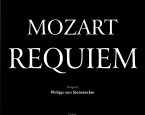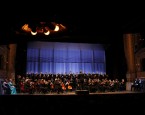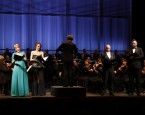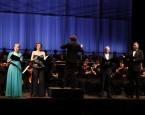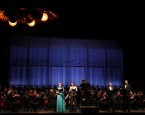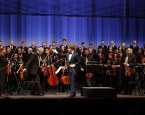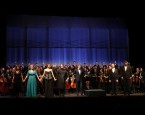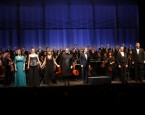
MOZART – REQUIEM
Wolfgang Amadeus Mozart (1756 – 1791): REQUIEM d-mol KV. 626
I. INTROITUS Requiem
II. KYRIE
III. SEQUENZA
1. Dies irae
2. Tuba mirum
3. Rex tremendae
4. Recordare
5. Confutatis
6. Lacrimosa
IV. OFFERTORIUM
1. Domine Jesu
2. Hostias
V. SANCTUS
VI. BENEDICTUS
VII. AGNUS DEI
VIII. COMMUNIO Lux aeterna
Requiem (lat.) – from the first word of the introit of the Mass for the Dead in Latin – Requiem aeternam dona eis, Domine (Eternal rest give to them, O Lord). In the Medieval, Baroque and Classical periods, Requiems were composed for the Mass for the Dead (missa pro defunctis) in Roman Catholic Church. It was first a monophonic liturgical chant, one of the oldest and most imaginative parts of the Gregorian chant. Since the 15th century, some parts were made polyphonic, while during the Romantic period, composers wrote Requiems on a larger scale, in terms of both length and required orchestral forces. In effect, they thus became dramatic oratorios, frequently operatic in style (Puccini, Verdi, Donizetti). Quite soon, the liturgical purpose of Requiems was altered into a concert one.
Due to its exceptional text with dramatic parts describing the Last Judgement that change into lyric ones with humble prayers for the salvation and repose of the dead soul, the Mass for the Dead has inspired numerous composers from the Medieval period until nowadays, of which the most famous next to Mozart are Berlioz, Dvořák, Brahms, Verdi, Bruckner, Vogler, Haydn, Gossec, Cherubini, Kozlovsky, von Suppé, Saint-Saëns and others.
Requiems of the twentieth century usually dispense with religious belief, some using a text derived from the philosophies of Nietzsche and Schopenhauer (Delius, A Pagan Requiem) or even employing parts of the Roman Mass for the Dead, taking greater liberties than ever before, such as Britten’s War Requiem that uses the poetry of W. Owen.
There is a remarkable mystery around the amazingly fascinating composer of the Requiem who was stopped by death itself in completing the brilliant work. It was Wolfgang Amadeus Mozart who was writing his immortal musical piece in Vienna in 1791, eventually leaving it unfinished.
The story of Mozart’s Requiem begins in Vienna in the July of 1791, when a skinny stranger knocked at the door of his flat in Rauhensteingasse, an intermediary of an anonymous master who commissions the Requiem for his beloved one (Count Franz von Walsegg-Stuppach, to commemorate the death of his wife). Mozart is given the advance of fifty ducats and the requirement for the work to be finished in a month. He agrees, needing the money, however, being exhausted by illness and busy day-and-night work he was aware that he would not be able to meet the deadline. At that time he is engaged with the writing of the The Magic Flute, his last Piano Concerto and a new commission from Prague, the premiere of La Clemenza di Tito to take place in five weeks. He could not refuse, as he feared losing the Emperor’s favour. He becomes seriously ill in September. The deadline for the Requiem is going to expire soon. Vienna and Prague have their new operas while the Requiem is still in sketches. The mysterious stranger is back, agrees to prolong the deadline for another month and pays another fifty ducats. Mozart had been working on the Requiem in his sick bed until the last moment of his 35-year life. This, regardless of illness, energetic work on his unique and dramatic music for the Mass for the Dead, was interrupted on the 5th of December in 1791. He did not finish his Requiem. The last words he set to music were from the Requiem’s Lacrimosa marking “that day of tears and mourning”.
Franz Xaver Süssmayr (1766 – 1803), his only student of composition, finished the masterpiece using Mozart’s sketches. In the second half of the 20th century, some musicologists, dissatisfied with Süssmayr’s work, attempted alternative completions of the Requiem. Among them were F. F. Beyer, D. Druce, C. Richard, F. Maunder, H. C. Robbins Landon, R. D. Levin and S. Andrews.
In his unique, inventive and markedly dramatic Requiem, Mozart uses arcane counterpoint and its evocation of liturgical archaism, reflecting and intensifying earlier models of musical grief.
Petar Kovačić, Rijeka Opera director, points out how special the concert of Mozart’s Requiem in Rijeka is: «It is with the instrumentarium that we begin approaching the philological interpretation. Thus, with this production of the Requiem we have the opportunity to hear basset horns instead of the usual clarinets, just as Mozart conceived. Mozart also wrote down a section of organ into the score, adding thus cohesion and rounded quality to the overall sound of the orchestra. So far, we have not been able to hear the Requiem in Rijeka that is so original, so genuinely Mozart’s.»

